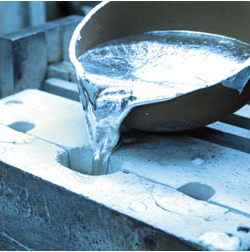Die Castings
 |
The process of die casting is the pouring of molten metal into a steel mold known as a die. The method of injecting the molten metal can make die casting a fast technique available for producing precise non-ferrous metal parts. Die castings are typically made from non-ferrous metals, such as zinc, copper, aluminum, magnesium, lead, pewter and tin based alloys. Die casting is a popular technique due to the range of complexity including multiple finishing techniques that it can produce. With die casting, parts can have a smooth or textured surface to allow for a variety of serviceable finishes. The degree for accuracy with die casting is high. Die casting has the ability to produce strong parts and will have greater stability and durability. If thin wall castings are in the design of a part, that part manufactured in a die cast will have strong walls. In addition to these advantages, die casting can reduce labor costs, waste and scrap. Die casting is suitable for small, medium and large quantity castings. One of the great characteristics of die casting is that it can be designed for production of complex shapes used in large quantity productions. Parts can be produced fast and many times can be economical. |


 Corporate Office | 2411 Crosspointe Drive, Miamisburg, OH 45342 | 937-247-9194 | (fax) 937-247-9468
Corporate Office | 2411 Crosspointe Drive, Miamisburg, OH 45342 | 937-247-9194 | (fax) 937-247-9468